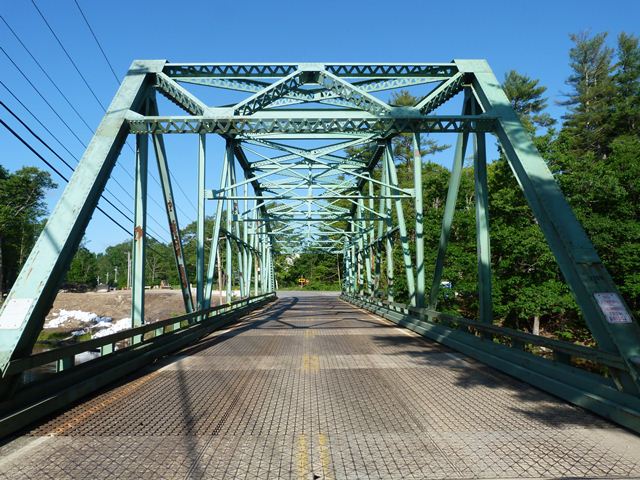We Recommend:
Bach Steel - Experts at historic truss bridge restoration.
BridgeHunter.com Phase 1 is released to the public! - Visit Now
Bonny Eagle Bridge

Primary Photographer(s): Nathan Holth
Bridge Documented: June 16, 2012
Hollis: York County, Maine and Cumberland County, Maine: United States
1939 By Builder/Contractor: American Bridge Company of New York, New York
Not Available or Not Applicable
155.0 Feet (47.2 Meters)
160.0 Feet (48.8 Meters)
22 Feet (6.71 Meters)
1 Main Span(s)
2190

View Information About HSR Ratings
Bridge Documentation
This bridge no longer exists!
View Archived National Bridge Inventory Report - Has Additional Details and Evaluation
This historic bridge is being replaced and will be demolished by MaineDOT as part of the project!
This bridge is an excellent example of a truss bridge in Maine built to a state standard plan. It displays the typical details of a standard truss from this period in Maine including use of a Warren truss, and the inclusion of a horizontal, longitudinal beam that runs through the middle of much of the truss web. The truss shows no major alterations and as such has good historic integrity.
The bridge has some areas that rehabilitation would be beneficial, such as addressing section loss that was arrested by application of paint, but not repaired, as well as addressing a deteriorated deck. However, overall the bridge, particularly the superstructure and substructure, are in overall decent condition. The condition of the bridge is such that it would likely be far less expensive to rehabilitate the bridge rather than replace it. That being the case, how does MaineDOT address a bridge with a deteriorated deck and minor super and sub structure repair needs? With a costly demolition and replacement project that will destroy this beautiful historic bridge and replace it with a mundane structure of extremely ugly appearance. A deteriorated deck does not mean the entire bridge should be replaced. It means that the bridge's deck needs to be replaced! It is bad enough that the state is wasting money replacing a bridge that could be economically rehabilitated, thus saving both money and history. However, the replacement bridge as outlined in the replacement bridge plans is located on a new alignment immediately south of the historic bridge. A brief glance at the bridge plans clearly shows that the historic bridge is not in the way of its replacement. Therefore, it would be feasible to complete the new bridge, while leaving the historic bridge standing, either closed off to all traffic as a historic exhibit to be viewed only, or to leave the bridge open to non-motorized traffic. In other words, even with the replacement bridge project, the demolition of the historic bridge is both pointless and a waste of taxpayer dollars. It would cost essentially nothing to leave the bridge standing. The bridge is strong enough to handle vehicular traffic at this time, therefore even without repair, it seems likely that the bridge would stand for perhaps decades without traffic on it. The Bonny Eagle Bridge is an example of something that occurs with unfortunate frequency; an example of how both tax dollars and history could have been saved but were not.
![]()
Photo Galleries and Videos: Bonny Eagle Bridge
Bridge Photo-Documentation
Original / Full Size PhotosA collection of overview and detail photos. This gallery offers photos in the highest available resolution and file size in a touch-friendly popup viewer.
Alternatively, Browse Without Using Viewer
![]()
Bridge Photo-Documentation
Mobile Optimized PhotosA collection of overview and detail photos. This gallery features data-friendly, fast-loading photos in a touch-friendly popup viewer.
Alternatively, Browse Without Using Viewer
![]()
Westbound Crossing
Full Motion VideoStreaming video of the bridge. Also includes a higher quality downloadable video for greater clarity or offline viewing.
![]()
Eastbound Crossing
Full Motion VideoStreaming video of the bridge. Also includes a higher quality downloadable video for greater clarity or offline viewing.
![]()
Maps and Links: Bonny Eagle Bridge
This historic bridge has been demolished. This map is shown for reference purposes only.
Coordinates (Latitude, Longitude):
Search For Additional Bridge Listings:
Bridgehunter.com: View listed bridges within 0.5 miles (0.8 kilometers) of this bridge.
Bridgehunter.com: View listed bridges within 10 miles (16 kilometers) of this bridge.
Additional Maps:
Google Streetview (If Available)
GeoHack (Additional Links and Coordinates)
Apple Maps (Via DuckDuckGo Search)
Apple Maps (Apple devices only)
Android: Open Location In Your Map or GPS App
Flickr Gallery (Find Nearby Photos)
Wikimedia Commons (Find Nearby Photos)
Directions Via Sygic For Android
Directions Via Sygic For iOS and Android Dolphin Browser
USGS National Map (United States Only)
Historical USGS Topo Maps (United States Only)
Historic Aerials (United States Only)
CalTopo Maps (United States Only)


